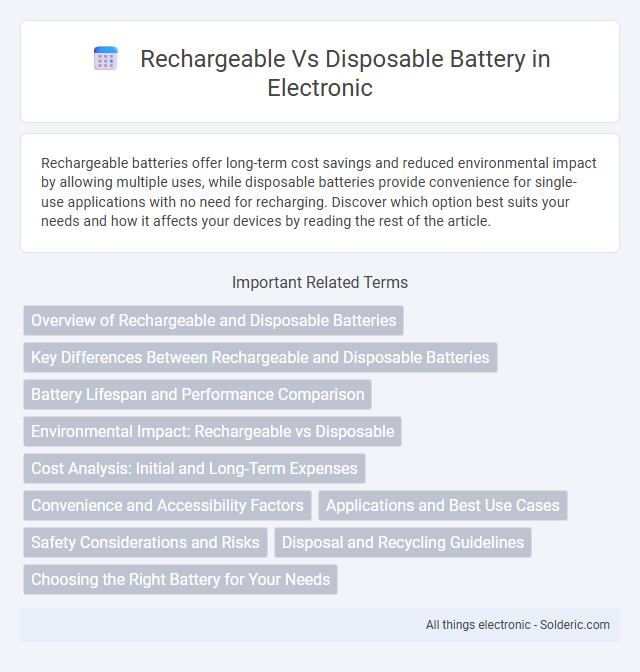Rechargeable batteries offer long-term cost savings and reduced environmental impact by allowing multiple uses, while disposable batteries provide convenience for single-use applications with no need for recharging. Discover which option best suits your needs and how it affects your devices by reading the rest of the article.
Comparison Table
| Feature | Rechargeable Battery | Disposable Battery |
|---|---|---|
| Cost | Higher initial cost, lower long-term cost | Low initial cost, higher long-term cost |
| Usage Cycle | Can be recharged and used hundreds of times | Single-use, disposed after depletion |
| Environmental Impact | Eco-friendly, less waste due to reuse | More waste, contributes to landfill volume |
| Energy Density | Lower energy density compared to disposables | Higher energy density, longer initial use |
| Self-Discharge Rate | Higher self-discharge rate | Lower self-discharge rate |
| Applications | Ideal for high-drain devices and frequent use | Suitable for low-drain or emergency devices |
| Examples | NiMH, Li-ion | Alkaline, Zinc-carbon |
Overview of Rechargeable and Disposable Batteries
Rechargeable batteries, such as lithium-ion and nickel-metal hydride types, offer long-term cost savings and environmental benefits due to their ability to be reused multiple times. Disposable batteries, including alkaline and zinc-carbon variants, provide convenience and immediate power but generate more waste and require frequent replacement. Understanding your device's power needs helps determine whether rechargeable or disposable batteries best suit your usage patterns.
Key Differences Between Rechargeable and Disposable Batteries
Rechargeable batteries can be used multiple times by recharging, offering cost savings and environmental benefits, while disposable batteries are single-use and must be replaced after depletion. Rechargeable batteries typically have a higher upfront cost but lower overall expense over time, whereas disposable batteries are cheaper initially but generate more waste. Your choice depends on usage frequency, with rechargeable batteries being ideal for high-drain devices and frequent use.
Battery Lifespan and Performance Comparison
Rechargeable batteries offer significantly longer lifespans, typically providing 300 to 500 charge cycles before noticeable capacity degradation, compared to disposable batteries which are single-use with a fixed energy output. Performance-wise, rechargeable batteries like NiMH and Li-ion maintain steady voltage during discharge, ensuring consistent power delivery, whereas disposable alkaline batteries experience voltage drop-off as they deplete. Over time, rechargeable batteries provide cost-effective and environmentally friendly power solutions due to their durability and ability to sustain performance through numerous recharge cycles.
Environmental Impact: Rechargeable vs Disposable
Rechargeable batteries significantly reduce environmental impact by decreasing the number of batteries discarded in landfills, as they can be used hundreds of times before replacement. Disposable batteries contribute to toxic waste accumulation due to heavy metals and chemicals that can leach into soil and water systems. Choosing rechargeable batteries helps your devices perform efficiently while supporting sustainability and minimizing hazardous waste pollution.
Cost Analysis: Initial and Long-Term Expenses
Rechargeable batteries typically have a higher initial cost compared to disposable batteries but offer significant savings over time due to their ability to be recharged hundreds of times, reducing the need for frequent replacements. In contrast, disposable batteries may seem cheaper upfront but incur greater long-term expenses as they require constant repurchasing for regular use. Evaluating total cost of ownership highlights the cost-effectiveness of rechargeable batteries, especially in high-drain devices or frequent use scenarios.
Convenience and Accessibility Factors
Rechargeable batteries offer greater convenience with their ability to be used multiple times, reducing the frequency of replacements and long-term cost. Disposable batteries remain accessible for immediate use in emergencies or low-drain devices, often found in stores worldwide without the need for recharging equipment. Your choice depends on balancing convenience for everyday use against accessibility in urgent or infrequent situations.
Applications and Best Use Cases
Rechargeable batteries are ideal for high-drain devices such as digital cameras, power tools, and smartphones, where frequent use justifies their higher initial cost and environmental benefits through repeated charging cycles. Disposable batteries excel in low-drain or emergency devices like remote controls, smoke detectors, and flashlights, offering convenience with longer shelf life and immediate usability. Your choice depends on the device's power demands and frequency of use to maximize efficiency and cost-effectiveness.
Safety Considerations and Risks
Rechargeable batteries typically offer enhanced safety features such as built-in overcharge protection and thermal regulation, reducing risks of leakage and explosions compared to disposable batteries. Disposable batteries pose greater hazards due to potential chemical leakage and environmental toxicity, especially when improperly disposed of. Both battery types require careful handling to prevent short circuits, overheating, and exposure to extreme temperatures to ensure user safety.
Disposal and Recycling Guidelines
Rechargeable batteries require specialized recycling programs due to their heavy metals, such as nickel, cadmium, and lithium, which pose environmental hazards if improperly disposed of. Disposable batteries must be taken to designated collection sites rather than thrown in regular trash to prevent toxic chemical leakage into soil and water. Understanding your local disposal and recycling guidelines ensures responsible battery handling and reduces ecological impact.
Choosing the Right Battery for Your Needs
Choosing the right battery depends on your usage patterns and environmental considerations. Rechargeable batteries offer long-term cost savings and reduced waste, making them ideal for high-drain devices and frequent use. Disposable batteries provide convenience and reliability for occasional or emergency needs, ensuring your devices work when you need them most.
Rechargeable vs Disposable battery Infographic

 solderic.com
solderic.com